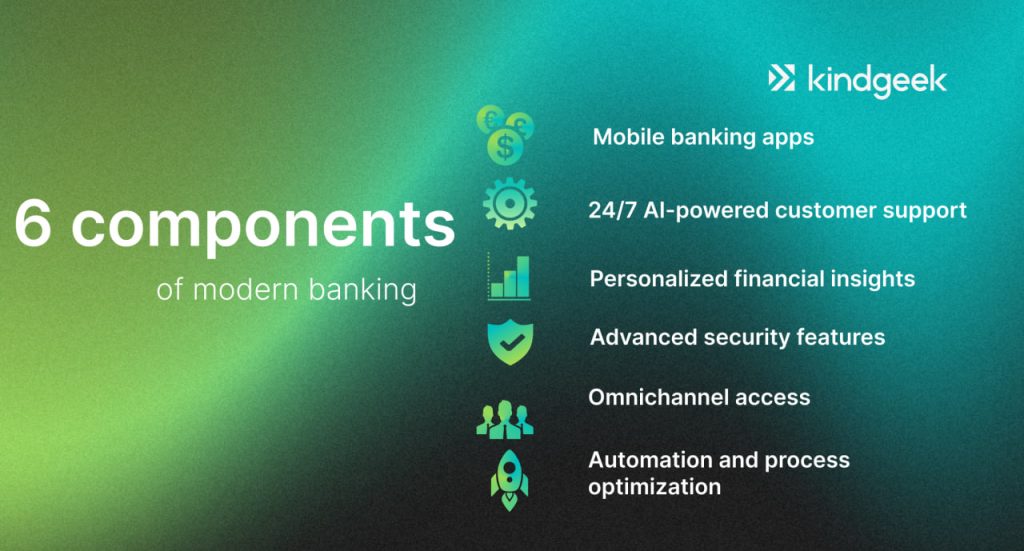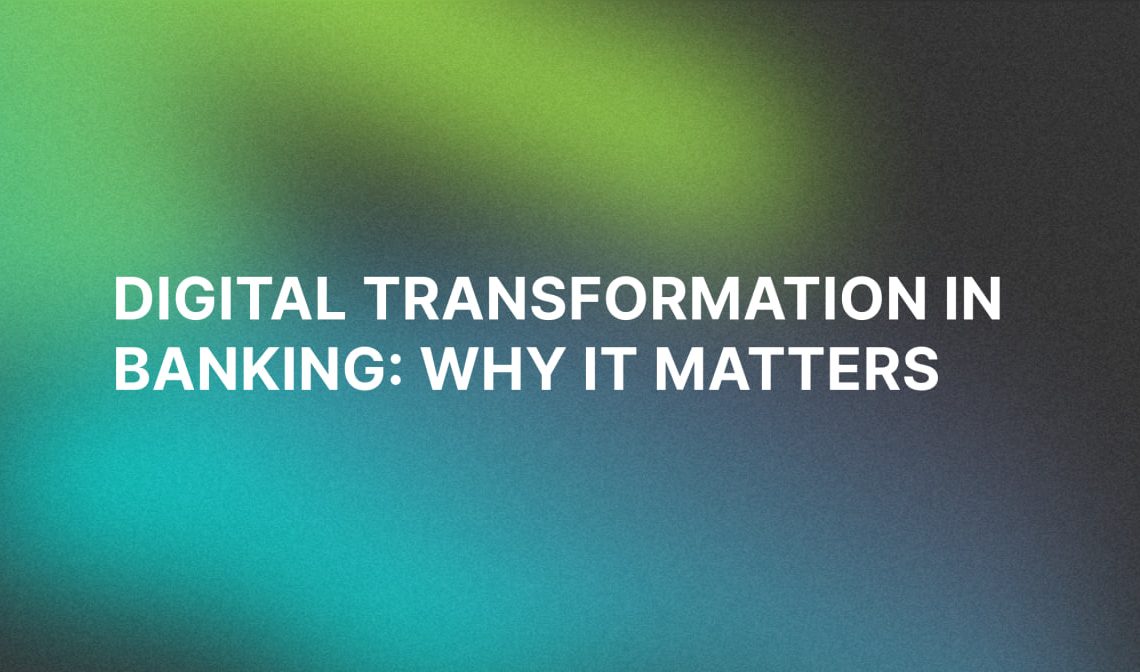Recently updated on April 18, 2025
Given the fast-paced market environment, digital transformation isn’t something to wonder at. Being driven by customer expectations and competitive pressures, digital transformation in banking requires companies to level up their game and relentlessly innovate to adapt to the evolving market landscape.
The recent industry data speaks for itself – the global spending on digital transformation is expected to surpass $3 trillion by 2025 and reach $3.9 trillion by 2027. Therefore, banking and digital transformation are becoming increasingly intertwined.
In this article, we’ll look into digital transformation in the banking industry, explore what impact it holds upon both banks and customers, and see what tech drives digital transformation in banks.
Content:
1. Exploring Digital Transformation in Banking
2. Benefits of digital transformation
3. Technologies Fueling Digital Transformation
Exploring Digital Transformation in Banking
Digital transformation in banking services involves a comprehensive process of adopting and integrating digital technologies to fundamentally reshape the delivery of financial services.
Global enterprise IT spending in the banking and investment services sector is projected to grow by 8.7% in 2024, reaching $735.6 billion. And over the next five years, spending is anticipated to achieve a compound annual growth rate (CAGR) of 9.3%, climbing to approximately $1 trillion by 2028.
But while the fundamental principles of banking remain unchanged, the way banks assist customers has evolved significantly. In today’s digital era, businesses must leverage modern technology to drive this transformation both internally and externally, enhancing customer experiences and elevating operational efficiency.
Here are some of the core components of modern banking that have become indispensable these days.

Mobile Banking Apps
Mobile apps are the cornerstone of digital banking, offering users access to their accounts anytime, anywhere. These apps combine sleek interfaces with powerful features like real-time account tracking, bill payments, and branchless banking, empowering users to manage finances with just a few taps.
24/7 AI-Powered Customer Support
AI-powered chatbots and virtual assistants provide round-the-clock customer support, ensuring help is always at hand. These tools can answer FAQs, assist with troubleshooting, and even detect and resolve basic issues without human intervention, reducing wait times and enhancing user satisfaction. And 69% of customers find it critical to have self-service options at hand.
Personalized Financial Insights
Digital banking platforms use AI to analyze user spending patterns and provide tailored insights. Such tools turn raw data into actionable advice, empowering users to take control of their finances. According to Deloitte, over 50% of bank customers find personalized services to be a critical factor shaping their trust and loyalty in financial providers
Advanced Security Features
Security is a top priority, and digital banking offers cutting-edge protection through features like two-factor authentication (2FA), and facial recognition. Alerts for suspicious activities and the ability to instantly freeze a card provide peace of mind, ensuring users feel safe while banking digitally.
Omni-Channel Access
Whether using a phone, tablet, laptop, or smartwatch, digital banking can ensure a unified experience. For example, a user can start a transaction on their phone and finish it on their smartwatch or laptop seamlessly. This continuity enhances convenience and accessibility, making banking fit into any device-centric lifestyle. And as per industry data, a staggering 75% of customers use multiple channels in their ongoing experience.
Automation and process optimization
By leveraging advanced technologies such as Robotic Process Automation (RPA), Artificial Intelligence, and Machine Learning, banks can streamline their internal operations, reduce costs, and improve overall operational efficiency.
This process involves the modernization of traditional banking systems, processes, and business models, enabling banks to deliver seamless, convenient, and secure services through various digital channels.
Benefits of digital transformation
Enhanced customer experience
Digital transformation offers a broad range of benefits for businesses, with one of the most significant being the enhanced customer experience. By leveraging digital tools and technologies, companies can better meet customer needs and expectations. Indeed, they should, as 73% of business leaders recognize a direct link between customer service and business performance.
Personalization at scale
Recent data from Salesforce and McKinsey shows that 73% of customers now anticipate personalized service, and 76% get frustrated when their individual needs are not met. By harnessing advanced data analytics, AI, and machine learning, businesses can personalize their products, services, and communications at scale to match individual customer preferences and behaviors.
Improved Data Analytics and Insights
Leveraging big data and AI enables fintechs to gain deep insights into customer behavior, market trends, and risk profiles, supporting informed decision-making. This enhanced analytical capability allows for more accurate forecasting and personalized financial products, which can lead to increased customer loyalty and higher profitability.
Greater Scalability
Cloud-based platforms and digital infrastructure make it easier for fintech companies to scale their services quickly to meet demand, whether locally or globally. This flexibility allows fintechs to enter new markets with minimal investment in physical infrastructure. Furthermore, scalable solutions can accommodate growing customer bases and transaction volumes without compromising performance or user experience.
Enhanced Security and Fraud Prevention
Advanced technologies such as blockchain, AI-powered fraud detection, and biometrics improve the security of financial transactions and protect against cyber threats. These innovations enable real-time monitoring of suspicious activities, quickly identifying and mitigating potential risks.
Cost Reduction
Automation and digital tools help streamline operations, reducing reliance on manual processes and physical infrastructure and ultimately lowering operational costs. By automating repetitive tasks, fintech companies can reallocate resources to more strategic initiatives, increasing productivity.
Innovation and Agility
Digital transformation fosters a culture of innovation, enabling fintech companies to quickly adapt to market changes, introduce new products, and stay ahead of competitors. Moreover, continuous access to cutting-edge technologies empowers them to experiment with new ideas, accelerating time-to-market for innovative solutions.
Technologies Fueling Digital Transformation
Here is a brief outline of the key technologies driving digital transformation for banks:
Artificial intelligence & machine learning
Without a trace of doubt, Artificial Intelligence and Machine Learning are two game-changing technologies in the financial sector. And the global market for AI in fintech is indeed huge, expected to reach $61.3 billion by 2031.
These technologies drive significant automation and augment staff in multiple ways. With AI and ML on board, fintechs and banks can streamline complex tasks, boost customer service, enhance personalization, strengthen fraud detection, supercharge decision-making and more. Being applied across several business functions – both in front- and back-office – 44% of businesses embrace AI exclusively to reduce their operational costs.
Cloud Computing
Cloud computing stands out as a pivotal technology behind digital transformation in banking, revolutionizing how financial institutions operate and serve their customers. Gartner predicts global public cloud end-user spending to exceed $675 Billion in 2024. By leveraging the cloud, banks can achieve unprecedented scalability, flexibility, and cost-efficiency.
This tech enables banks to store vast amounts of data securely and access it in real time, facilitating better decision-making and personalized customer experiences. And cloud computing also supports the rapid deployment of new applications and services, allowing banks to respond swiftly to market demands and regulatory changes.
Blockchain
Blockchain technology is a pivotal force driving digital transformation in the banking industry, offering robust solutions to longstanding challenges and enabling new opportunities for innovation. By providing a decentralized, secure, and transparent ledger system, blockchain enhances the efficiency and security of financial transactions.
One of the primary benefits of blockchain in banking is its ability to facilitate faster and more cost-effective transactions. Traditional banking processes, particularly cross-border payments, often involve multiple intermediaries and can take several days to complete. Blockchain technology streamlines these processes by enabling direct peer-to-peer transfers, reducing transaction times from days to mere minutes, and significantly lowering associated fees.
White-label platforms
Creating a fintech product from the ground up can be a time-intensive and resource-heavy endeavor. A white-label fintech platform, however, can offer a more efficient alternative. By providing a comprehensive suite of pre-built features, along with options for customization and further development, it enables you to quickly launch your online finance business or transition to digital without requiring significant upfront investment.
While a white-label solution may not be the sole component of digital transformation, it can significantly contribute to the process by facilitating innovation, reducing time to market, and enabling businesses to focus on enhancing customer experiences and operational efficiencies.
Consider Kindgeek for the digital transformation journey
Whether you need a glow-up or a complete overhaul, Kindgeek can help you transform your vision into reality. Kindgeek is a one-stop-shop product development partner that empowers finance organizations to unlock their full potential through innovative digital solutions.
With over 200 companies trusting us to build their MVPs, products, and scale engineering teams, we’re at the forefront of driving digital transformation. Embrace any type of integration, open banking, chatbots, BNPL, core banking, blockchain, and more through our expert approach.
Final thoughts
Nevertheless, it’s important to keep in mind that digital transformation for banking isn’t a one-time project. That’s colossal work that requires tech expertise, clear strategic vision, and immense management capabilities. As technology evolves, so does the need to keep abreast of new developments and continuously adapt. This ongoing process requires a proactive approach, where organizations must regularly evaluate their technological landscape, identify emerging trends, and implement innovative solutions to maintain a competitive edge.
Besides, the commitment to digital transformation extends beyond technology; it encompasses changes in organizational culture, processes, and employee skillsets, ensuring that the entire organization is aligned and capable of thriving in an increasingly digital world. This is especially true in the context of banking and digital transformation, where financial institutions must adapt to meet the evolving demands of their customers while maintaining security and efficiency.




